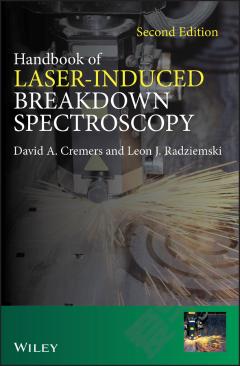Handbook of Laser-Induced Breakdown Spectroscopy
Foreword. Preface. Acronyms, Constants, And Symbol.s 1. History. 1.1 Atomic optical emission spectrochemistry (OES). 1.2 Laser-induced breakdown spectroscopy (LIBS). 1.3 LIBS History 1960-1980. 1.4 LIBS History 1980-1990. 1.5 LIBS History 1990-2000. 1.6 Active Areas of Investigation, 2000-2002. References. 2. Basics of the LIBS plasma. 2.1 LIBS plasma fundamentals. 2.2 laser-Induced Breakdown. 2.3 laser ablation. 2.4 double or multiple pulse libs. 2.5 summary. References. 3. Apparatus fundamentals. 3.1 Basic LIBS apparatus. 3.2 Lasers. 3.3 Optical systems. 3.4 Methods of spectral resolution. 3.5 Detectors. 3.6 Detection system calibration. 3.7 Timing considerations. 3.8 Methods of LIBS deployment. References. 4. Determining LIBS analytical figures-of-merit. 4.1 Introduction. 4.2 Basics of LIBS measurements. 4.3 precision. 4.4 Calibration. 4.5 Detection limit. References. 5. Qualitative LIBS Analysis. 5.1 Identifying elements. 5.2 Material identification. 5.3 Process control. References. 6. Quantitative LIBS Analysis. 6.1 Introduction. 6.2 Geometric Sampling Parameters. 6.3 Other sampling considerations. 6.4. Particle size. 6.5 use of internal standardization. 6.6 Chemical Matrix effects. 6.7. Example of libs measurement: Impurities in Lithium Solutions. 6.8 Reported figures of merit for LIBS measurements. 6.9 Conclusions. References. Chapter 7. REMOTE LIBS MEASUREMENTS. 7.1 Introduction. 7.2 Conventional open path LIBS. 7.3 Stand-off LIBS using Femtosecond pulses. 7.4 Fiber optic LIBS. References 8. Examples of recent LIBS fundamental research, instruments and novel applications. 8.1 Introduction. 8.2 fundamentals. 8.3 calibration-free LIBS. 8.4 laser and spectrometer advances. 8.5 surface analysis. 8.6 Double pulse studies and applications. 8.7 Steel applications. 8.8 libs for biological applications. 8.9 nuclear reactor applications. 8.10 LIBS for space applications. References. 9. THE FUTURE OF LIBS. 9.1 Introduction. 9.2 Expanding the understanding and capability of the libs process. 9.3 Widening the universe of libs applications. 9.4 Factors that will speed the commercialization of Libs. 9.5 conclusion. References. APPENDIX A: Safety Considerations in LIBS. A.1. safety plans. A.2 Laser Safety. A.3 Generation of Aerosols. A.4 laser pulse induced ignition. APPENDIX B: LIBS Application Matrix. APPENDIX C: LIBS Detection Limits. C.1 detection limits from the literature. C.2 uniform detection limits. APPENDIX D: Major LIBS References. Index.
{{comment.content}}








 京公网安备 11010802027623号
京公网安备 11010802027623号